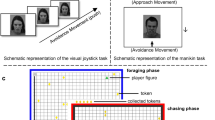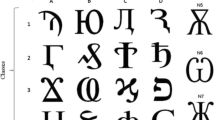Abstract
Behavioral avoidance testing is a substantial addition to self-report questionnaires in the assessment of agoraphobia. However, the tests currently in use have drawbacks and limitations. A multitask behavioral avoidance test (M-BAT) is presented, designed to meet some of these problems. The test was administered to a group of 58 patients and proved to be reliable in terms of internal consistency. Concordance with self-report measures of agoraphobia indicated a high concurrent validity. In comparison with self-report questionnaires, the tests produced a slightly more conservative picture of gains achieved in treatment. Finally, the data revealed that the multitask test was more concordant with other measures of agoraphobia than a single-task test would have been.
Similar content being viewed by others
References
Agras, W. S. & Jacob, R. G. (1981). Phobia: Nature and measurement. In M. Mavissakalian & D. H. Barlow (Eds.),Phobia: Psychological and pharmacological treatment. New York: Guilford.
Agras, W. S., Leitenberg, H., & Barlow, D. H. (1968). Social reinforcement in the modification of agoraphobia.Archives of General Psychiatry, 19, 423–427.
American Psychiatric Association (1987).Diagnostic and statistical manual of mental disorders—third edition — Revised. Washington DC: APA.
Arnow, B. A., Taylor, C. B., Agras, W. S., & Telch, M. J. (1985). Enhancing agoraphobia treatment outcome by changing couple communication patterns.Journal of Behavior and Therapy 16(5), 452–467.
Arrindell, W. A., & Ettema, J. H. M. (1986).SCL-90: Handleiding bij een multidimensionele psychopathologie-indicator (SCL-90: Manual for a multidimensional indicator of psychopathology). Lisse, The Netherlands: Swets and Zeitlinger.
Arrindell, W. A., Emmelkamp, P. M. G., & Van der Ende, J. (1984). Phobic dimensions: I. Reliability and generalizability across samples, gender and nations.Advances in Behaviour Research and Therapy, 6, 207–254.
Arrindell, W. A., Emmelkamp, P. M. G., & Sanderman, R. (1986). Marital quality and general life adjustment in relation to treatment outcome in agoraphobia.Advances in Behaviour Research and Therapy, 8, 139–185.
Borkovec, T. D., Weerts, T. C., & Bemstein, D. A. (1977). Assessment of anxiety. In A. R. Ciminero, K. S. Calhoun, & H. E. Adams (Eds.),Handbook of behavioral assessment. New York: John Wiley & Sons.
Chambless, D. L., Foa, E. B., Groves, G. A., & Goldstein, A. J. (1979). Flooding with brevital in the treatment of agoraphobia: Countereffective?Behaviour Research and Therapy, 17, 243–251.
Chambless, D. L., Caputo, G. C., Jasin, S. E., Gracely, E. J., & Williams, C. (1985). The mobility inventory for agoraphobia.Behaviour Research and Therapy, 23, 35–44.
Craske, M. G., Street, L., & Barlow, D. H. (1989). Instructions to focus upon or distract from internal cues during exposure treatment of agoraphobic avoidance.Behaviour Research and Therapy, 27, 663–672.
Derogatis, L. R., Lipman, R. S., & Covi, L. (1973).SCL-90: An outpatient psychiatric rating scale: A preliminary report.Psychopharmacology Bulletin, 9, 13–27.
De Ruiter, C., Garssen, B., Rijken, H., & Kraaimaat, F. (1987). Anxiety Disorders Interview Schedule-Revised: Dutch translation. Utrecht, The Netherlands: Department of Psychiatry, University of Utrecht.
DiNardo, P. A., O'Brien, G. T., Barlow, D. H., Waddell, M. T., & Blanchard, E. B. (1983). Reliability of DSM-III anxiety disorder categories using a new structured interview.Archives of General Psychiatry, 40, 1070–1074.
Doctor, R. M. (1982). Major results of a large-scale pretreatment survey of agoraphobics. In R. L. DuPont (Ed.),Phobia: A comprehensive summary of modern treatments (pp. 203–214). New York: Bruner/Mazel.
Emmelkamp, P. M. G. (1974). Self-observation versus flooding in the treatment of agoraphobiaBehaviour Research and Therapy, 12, 229–237.
Emmelkamp, P. M. G. (1979). The behavioural study of clinical phobias.Progress in Behaviour Modification, 8, 55–125.
Emmelkamp, P. M. G. (1982).Phobic and obsessive-compulsive disorders. New York: Plenum Press.
Eysenck, S. B. G., Eysenck, H. J., & Barrett, P. (1985). A revised version of the psychoticism scale.Personality and Individual Differences, 6, 21–29.
Hersen, M., & Bellack, A. S. (1976). Behavioral assessment: A practical handbook. Oxford: Pergamon.
Himadi, W. G., Boice, R., & Barlow, D. H. (1986). Assessment of agoraphobia II: Measurement of clinical change.Behaviour Research and Therapy, 24, 321–332.
Jacobson, N. S., & Revenstorf, D. (1988). Statistics for assessing the clinical significance of psychotherapy techniques: Issues, problems and new developments.Behavioral Assessment, 10, 133–145.
Kraft, A., Hoogduin, K., & Bekker, F. (1982). Een onderzoek naar de effectiviteit van vier behandelingsmethoden bij cliënten met hyperventilatieaanvallen: een pilot-study (An investigation into the effectiveness of four treatment methods for clients with hyperventilation attacks: A pilot study).Tijdschrift voor Psychotherapie, 8, 269–277.
Lang, P. J. (1971). The application of psychophysiological methods to the study of psychotherapy and behavior modification. In. A. E. Bergin & S. L. Garfield (Eds.),Handbook of psychotherapy and behavior change. New York: Wiley.
Lick, J. R., & Katkin, E. S. (1976). Assessment of anxiety and fear. In M. Hersen & A. S. Bellack (Eds.),Behavioral assessment: A practical handbook (pp. 175–206). Oxford: Pergamon.
Lick, J. R., & Unger, T. (1977). The external validity of behavioral fear assessment.Behavior Modification, 1, 283 -305.
Marks, I. M., & Matthews, A. M. (1979). Brief standard self-rating for phobic patients.Behaviour Research and Therapy, 17, 263–267.
Mathews, A. M., Gelder, M., & Johnston, D. W. (1981).Agoraphobia: Nature and Treatment. New York: Guilford Press.
Mavissakalian, M., & Hamann, M. S. (1986). Assessment and significance of behavioral avoidance in agoraphobia.Journal of Psychopathology and Behavioral Assessment, 8, 199–210.
Mavissakalian, M., & Michelson, L. (1984). The role of selfdirected in vivo exposure in behavioral and pharmacological treatments of agoraphobia.Behavior Therapy, 14, 506–519.
McReynolds, W. T., & Tori, C. A. (1972). A further assessment of attention-placebo effects and demand characteristics in studies of systematic desensitisation.Journal of Consulting and Clinical Psychology, 38, 261–264.
Michelson, L. (1987). Cognitive-behavioral assessment and treatment of agoraphobia. In: L. Michelson, & L. M. Ascher (Eds.),Anxiety and stress disorders: Cognitive-behavioral assessment and treatment. New York: Oxford Press.
Michelson, L., & Mavissakalian, M. (1983). The temporal stability of self-report measures in agoraphobia research.Behaviour Research and Therapy, 21, 695–698.
Michelson, L., Mavissakalian, M., & Marchione, K. (1988). Cognitive, behavioral and psychophysiological treatment of agoraphobia: A comperative outcome investigation.Behavior Therapy, 19, 97–120.
Miller, B. V., & Bernstein, D. A. (1972). Instructional demand in a behavioural avoidance test for claustrophobic fears.Journal of Abnormal Psychology, 80, 206–210.
O'Brien, G. T., & Barlow, D. H. (1984). Agoraphobia. In S. M. Turner (Ed.),Behavioural theory and treatment of anxiety. New York: Plenum Press.
Öst., L. -G., Jerremalm, A., & Jansson, L. (1984). Individual response patterns and the effects of different behavioural methods in the treatment of agoraphobia.Behaviour Research and Therapy, 22, 697–707.
Rachman, S., & Hodgson, R. (1974). Synchrony and desynchrony in fear and avoidance.Behaviour Research and Therapy, 12, 311–318.
Spielberger, C. D., Gorsuch, R. L., & Lushene, R. E. (1970).Manual for the state-trait anxiety inventory. Palo Alto, CA: Consulting Psychology Press.
Telch, M. J. Agras, W. S. Taylor, C. B., Roth, W. T., & Gallen, C. C. (1985). Combined pharmacological and behavioural treatment for agoraphobia.Behaviour Research and Therapy, 23, 325–335.
van Rooijen, L., & Arrindell, W. A. (1987). Depressiegevoelens bij psychiatrische patienten en hun partners: betrouwbaarheid en validiteit van de vropsom-lijsten. (Feelings of depression with psychiatric patients and their spouses: Reliability and validity of the vropsom-lists).Gedrag en gezondheid, 15, 65–73.
Williams, S. L. (1985). On the nature and measurement of agoraphobia In M. Hersen, R. M. Eisler, & P. M. Miller (Eds.),Progress in behavior modification (Vol. 19, 109–144). New York: Academic Press.
Winer, B. J. (1971).Statistical principles in experimental design (2nd ed.). Kogakusha, Tokio: McGraw-Hill.
Wolpe, J., & Lang, P. J. (1964). A fear survey schedule for use in behaviour therapy.Behaviour Research and Therapy, 2, 27–30.
Author information
Authors and Affiliations
Rights and permissions
About this article
Cite this article
de Beurs, E., Lange, A., Van Dyck, R. et al. Behavioral assessment of avoidance in agoraphobia. J Psychopathol Behav Assess 13, 285–300 (1991). https://doi.org/10.1007/BF00960442
Accepted:
Issue Date:
DOI: https://doi.org/10.1007/BF00960442




